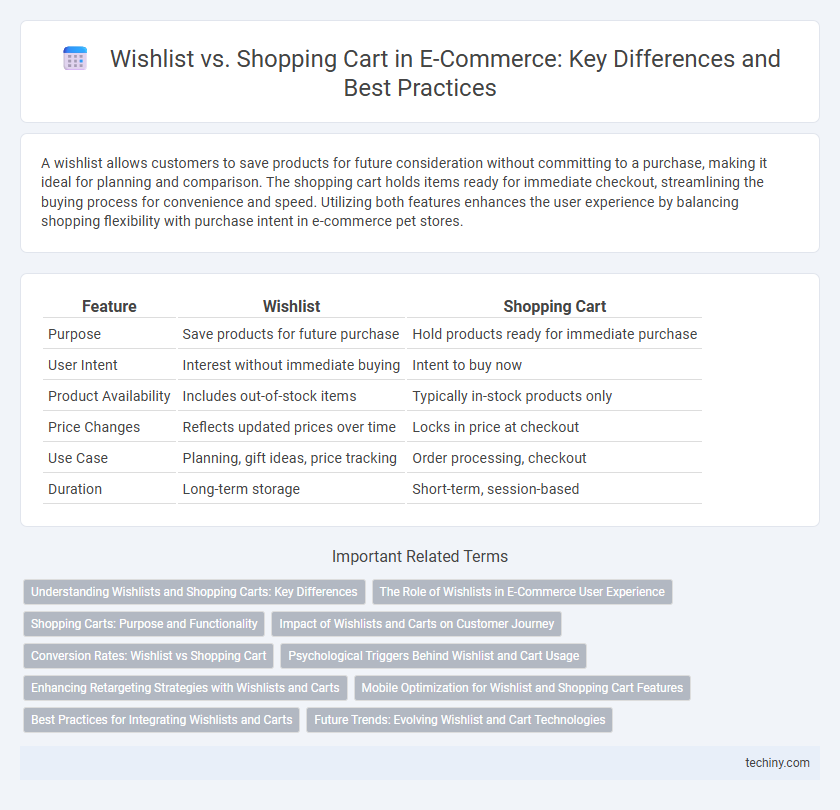A wishlist allows customers to save products for future consideration without committing to a purchase, making it ideal for planning and comparison. The shopping cart holds items ready for immediate checkout, streamlining the buying process for convenience and speed. Utilizing both features enhances the user experience by balancing shopping flexibility with purchase intent in e-commerce pet stores.
Table of Comparison
| Feature | Wishlist | Shopping Cart |
|---|---|---|
| Purpose | Save products for future purchase | Hold products ready for immediate purchase |
| User Intent | Interest without immediate buying | Intent to buy now |
| Product Availability | Includes out-of-stock items | Typically in-stock products only |
| Price Changes | Reflects updated prices over time | Locks in price at checkout |
| Use Case | Planning, gift ideas, price tracking | Order processing, checkout |
| Duration | Long-term storage | Short-term, session-based |
Understanding Wishlists and Shopping Carts: Key Differences
Wishlists enable customers to save products for future consideration without commitment, enhancing personalized shopping experiences and increasing long-term engagement. Shopping carts store selected items intended for immediate purchase, streamlining the checkout process and boosting conversion rates. Clear differentiation between these tools helps e-commerce platforms optimize user experience and drive sales growth.
The Role of Wishlists in E-Commerce User Experience
Wishlists play a crucial role in e-commerce by allowing users to save desired products for future purchase, enhancing customer engagement and increasing return visits. Unlike shopping carts, which are intended for immediate or near-term transactions, wishlists facilitate long-term planning and personalized product discovery. Integrating wishlists with user profiles and targeted marketing strategies improves conversion rates and customer satisfaction.
Shopping Carts: Purpose and Functionality
Shopping carts serve as temporary storage for items customers intend to purchase during a single online shopping session, streamlining the checkout process and enhancing user experience. They facilitate quantity adjustments, price updates, and product removal while calculating taxes and shipping fees in real-time. Optimized shopping cart functionality reduces cart abandonment rates and boosts conversion by providing seamless navigation from selection to payment.
Impact of Wishlists and Carts on Customer Journey
Wishlists enhance the customer journey by allowing users to save desired products for future consideration, increasing brand engagement and personalized marketing opportunities. Shopping carts drive immediate purchase intent by aggregating selected items, streamlining the checkout process, and reducing cart abandonment rates through reminders and incentives. Together, they balance long-term customer retention and short-term conversion, optimizing overall e-commerce sales performance.
Conversion Rates: Wishlist vs Shopping Cart
Shopping carts directly impact conversion rates by facilitating immediate purchases, while wishlists primarily serve as a long-term engagement tool, increasing potential conversion opportunities over time. Data shows that items moved from wishlists to shopping carts have a higher conversion likelihood compared to products viewed only once. Optimizing the transition from wishlist to shopping cart can significantly boost e-commerce sales performance.
Psychological Triggers Behind Wishlist and Cart Usage
Wishlists tap into the psychological trigger of aspiration, allowing customers to envision future purchases and satisfy the desire for ideal possessions without immediate commitment. Shopping carts leverage the urgency and readiness to buy, activating decision-making processes linked to immediate gratification and reducing purchase hesitation. Understanding these cognitive triggers helps e-commerce platforms optimize user experience and increase conversion rates by strategically designing wishlist and cart functionalities.
Enhancing Retargeting Strategies with Wishlists and Carts
Wishlists capture long-term purchase intent, enabling e-commerce retailers to segment users based on product interest and frequency, while shopping carts highlight immediate buying intent, which helps prioritize high-conversion retargeting campaigns. Data from wishlists allows personalized email reminders and exclusive promotions to nurture hesitant buyers, whereas abandoned cart analytics trigger timely incentives like discounts or free shipping to recover potentially lost sales. Integrating wishlist and cart behavior offers granular insights that optimize retargeting effectiveness, boost customer lifetime value, and reduce shopping cart abandonment rates.
Mobile Optimization for Wishlist and Shopping Cart Features
Mobile optimization for wishlist and shopping cart features significantly enhances the e-commerce user experience by enabling seamless access and interaction on smaller screens. Responsive design ensures that wishlist items and cart contents are easy to view, manage, and update with touch-friendly buttons and fast loading times. Optimizing these features for mobile increases user engagement, reduces cart abandonment rates, and supports higher conversion rates through intuitive navigation and quick checkout processes.
Best Practices for Integrating Wishlists and Carts
Integrating wishlists and shopping carts enhances user experience by allowing seamless transition from saving desired products to purchasing them, increasing conversion rates. Implement best practices such as syncing wishlist items with the cart to avoid duplication, providing clear options to move items between lists, and enabling cross-device synchronization for consistent access. Optimizing these features with personalized recommendations and persistent data storage boosts customer engagement and retention in e-commerce platforms.
Future Trends: Evolving Wishlist and Cart Technologies
Emerging trends in e-commerce reveal wishlists evolving into personalized AI-driven recommendation hubs, seamlessly integrating user preferences and behavioral data for predictive shopping experiences. Shopping carts are adopting real-time inventory synchronization and dynamic pricing algorithms to enhance conversion rates and reduce abandonment. Enhanced interoperability between wishlist and cart systems is expected to streamline the buyer journey, leveraging machine learning to provide adaptive, context-aware purchasing options.
Wishlist vs Shopping Cart Infographic

 techiny.com
techiny.com